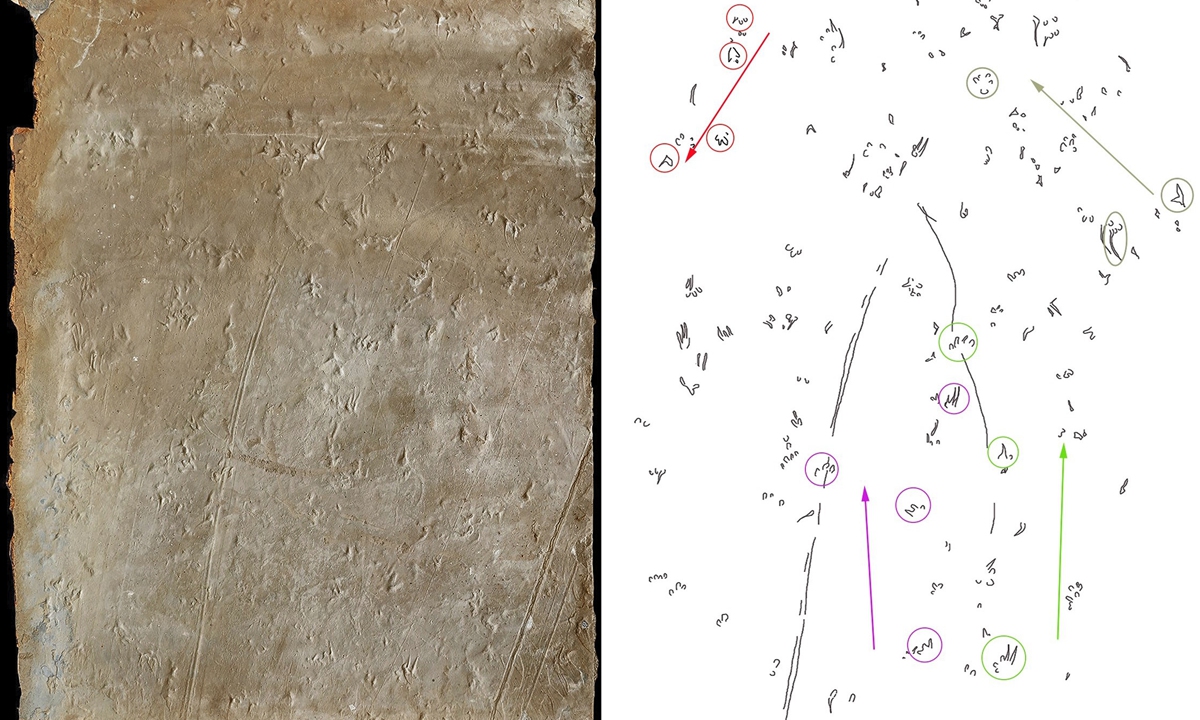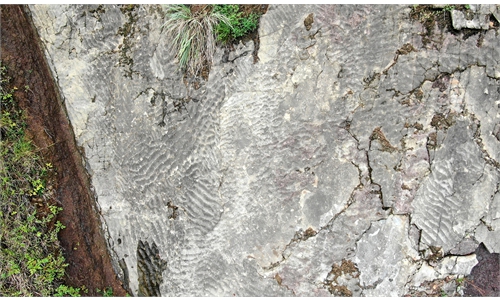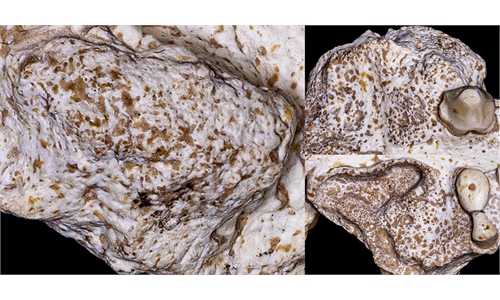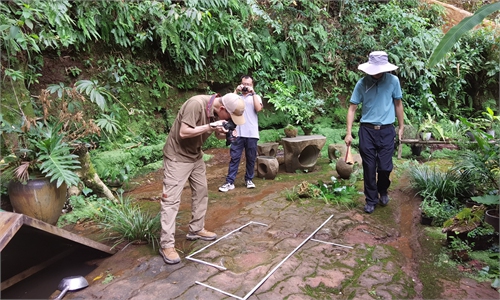Horseshoe crab trace fossils dating 200 million years ago found for the first time in NW China’s Shaanxi

Image of the horseshoe crab trace fossils discovered in Hengshan district in Yulin city, Northwest China's Shaanxi Province. Photo: Courtesy of Xing Lida
A group of trace fossils have been discovered for the first time in Northwest China's Shaanxi Province which proved to belong to horseshoe crabs and fish dating back to 200 million years ago, expanding the geographical and temporal distribution of horseshoe crab trace fossils discovered in China, an international team of paleontologists announced on Sunday.
The horseshoe crab, known as "living fossil," is a species of extremely rare arthropod. Its body is divided into three sections including the prosoma or head, the abdomen or opisthosoma, and the spike-like tail, which is called the telson.
Besides, a horseshoe crab has six paired appendages including one pair of appendages located in front of its mouth to pick up food and five pairs of legs for "walking."
The trace fossil assemblage of horseshoe crabs and fish were unearthed in May of 2006 in Hengshan district in Yulin, Shaanxi, Ordos Basin.
The horseshoe crabs' traces, suspected then to be left by some quadruped, together with the traces of fish, were found on more than 30 flagstones by local collectors from the Yulin City Folk Collection Association in a local quarry.
Hengshan district is China's major producing area for trace fossils dating back to Late Triassic epoch.
The history of fossil discovery in this area dates back to the summer of 1997 when traces of invertebrate animals were found in the process of stone material production. Those stones were once widely used by local residents as floor tiles and tombstones, and for paving roads.
In 2019, a research team led by Xing Lida, associate professor from China University of Geosciences in Beijing, investigated the quarry and surrounding strata and conducted research on the flagstones, confirming that the traces were left by horseshoe crabs instead of quadruped.
The traces of horseshoe crabs accompanying that of fish showed the remarkable morphological diversity, according to a statement that Xing shared with the Global Times.
The fossil specimens are made up of 17 identifiable lines of horseshoe crab traces and at least 60 individual footprints.
The traces of horseshoe crabs are usually created by the last pair of its legs. The characteristic of horseshoe crabs' traces that clearly distinguishes them from tetrapod footprints is their long and forked shape at the back of their traces.
Among some traces, the researchers also observed the straight or slightly serpentine traces left by the horseshoe crabs' telson.
Based on the irregular traces left by the telson and the legs, the scientists determined that the traces were left by individual horseshoe crabs floating or swimming and individuals walking on the bottom of the lake.
Similar fossils of horseshoe crabs' movement traces have been found across China including Nanling county in East China's Anhui Province, Jinghong in Southwest China's Yunnan Province and Huaxi in Southwest China's Guizhou Province.
Compared with the horseshoe crabs in those areas, the horseshoe crabs in Hengshan were much bigger in size. According to the length formula, the maximum length of an individual horseshoe crab can be up to 89 centimeters, which can be the largest horseshoe crab in the Chinese fossil records.
Fish swimming fossils are also abundant in Hengshan.
These fossils were left by fish when they drag their pelvic, pectoral and caudal fins, or other body bumps over the surface of sediment as they swim. Based on the shapes of the traces, the scientists decided that they were left by three to five species of demersal fish, also known as groundfish, which had different fin development patterns and movement patterns. Among them, there may be the paleonisciforms commonly seen in the Triassic stratum in Ordos Basin.
Apart from these, the strata left no evidence of other potential prey, suggesting that creatures that floated and swam in the water, such as crustaceans and small fish, were part of the food chain of the creatures which left the traces.
Such new discovery of the trace fossil assemblage of horseshoe crabs and fish in Hengshan carries great significance, according to the scientists.
Since it was the first time that horseshoe crabs' traces were identified in the Upper Triassic of Hengshan area, which not only expands the geographical and temporal distribution of horseshoe crab trace fossils discovered in China, but also has implications for the restoration of local paleobiocenosis and palaeoenvironment.
The unusual diversity of the trace fossils indicates the existence of a rich shallow-water paleobiocenosis consisted of horseshoe crabs and fish. The paleoenvironment may have been a shallow lake from freshwater to salt water with an input of siliceous sediments.
The research published in the latest issue of Historical Biology, an international peer-reviewed scientific journal of paleobiology, was an achievement made with the joint efforts of scientists from China and Germany.
Global Times



